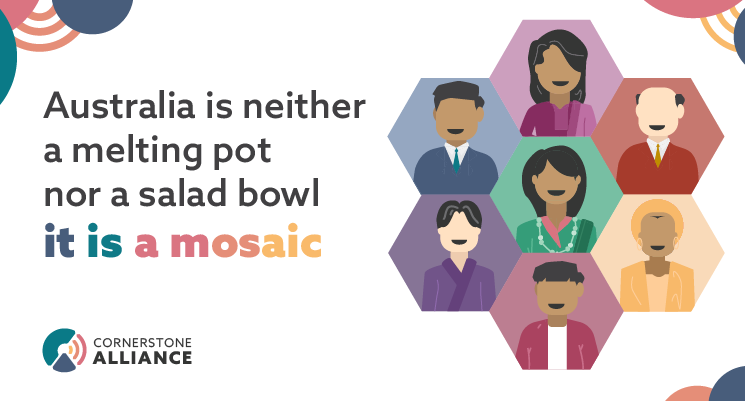Written by Samoda Silva
Is Australia a melting pot or a salad bowl? These metaphors, amongst variations, have illustrated the different approaches to cultural integration within the country and have been heavily debated alongside the developments in migration and multiculturalism.
Some may say that the Australian culture is a melting pot of contributions from the many diverse cultural groups who have migrated to Australia, and, in the process, have brought to the national table their foods, traditions, festivals and much more to the Australian identity. However, there has been a growing push against the ‘melting pot’ metaphor, recognising that Australia is not a place where cultures assimilate and become one. Rather, there is the emerging interest to recognise the term ‘salad bowl’ (or a quilted blanket, fruit salad or some other variation) as a more accurate reading of Australia’s multicultural status quo, symbolising a more progressive approach to multiculturalism that recognises individual cultures as having their own distinct identities, yet they come together within the collective space of Australia.
Australia has progressed significantly in its internal views and external policies surrounding migration and multicultural affairs. We have moved past the stage where preserving national purity in the form of the White Australia Policy was seen as a priority and a necessity, and towards a collective understanding that an active migration program and thriving multicultural communities have benefits for all of us. A 2021 survey found that 86% of respondents agreed with the statement that ‘multiculturalism has been good for Australia’ and 76% agreed that ‘accepting immigrants from many different countries makes Australia stronger’[1].
Similarly, but more recently, we have moved past the stage where multiculturalism and interculturalism are new and foreign concepts. Cultural diversity is the norm, and is reflected in Australian attitudes, policy, legislation, and representation, amongst others. Australians largely embrace multiculturalism and are welcoming of persons born overseas, traditions and festivals, clothes and fabrics, foods and cuisines, and much more, and these aspects have become so woven into the norm that we often do not categorise things as foreign.
So, where do we go from here?
If we have to define Australia as something, then why pigeonhole it using a set of metaphors that, were developed to illustrate American society, and were introduced at a time when even the thought of Australia as a multicultural society was beyond us?
So, what can be used as a more contemporary illustration of Australia’s multicultural society?
This is where the idea of a ‘mosaic’ can come into play.
Cultural diversity is the norm, and is reflected in Australian attitudes, policy, legislation, and representation…”
The mosaic metaphor supports the idea of interculturalism, where many cultures not only exist collectively in one place but are supported as one by the existence of others. The beauty of a mosaic is not due to merely one shade of tile, but because of the appearance of many. You take one shade out of the piece, and the mosaic would look a lot different. If each tile were to represent a culture within the Australian population, then the mosaic allows each culture to be displayed individually with their own distinct identity yet come together as one. The culture may not stand out amongst the sea of others, but the culture does not lose its identity within the mosaic, nor does it have to amalgamate with the others in the piece.
The idea of the mosaic appreciates that migrants have their own traditions, values, history, and heritage that they bring that cannot and should not detach from one’s person as soon as they leave one country for another. It is in Australia’s collective best interests to see these embedded character features thrive, rather than be stifled.
Going deeper into the extended metaphor, in the same way that a mosaic doesn’t just become crafted, the thing to keep in mind is that multiculturalism is not passive – we have to make the effort to craft it. The construction of the cultural mosaic is supported by public policy and legislation that supports multicultural Australians who have chosen to settle in Australia, and public attitudes that demonstrate a welcoming of migrants and refugees who look to Australia as a place with ‘boundless plains to share’. The mosaic requires efforts from all Australians, regardless of cultural background, to contribute to its assembly and support its framework.
…multiculturalism is not passive – we have to make the effort to craft it.”
The mosaic will continue to evolve and expand as Australia’s people, story, and environment change, and adapt. We shouldn’t expect the mosaic of today to resemble that of next year, and even more so thirty years from now. The strength of the mosaic concept is that on an endless wall waiting to be adorned with new tiles, we have room to grow and room to add more tiles that enrich the Australian cultural landscape.
And in the same way that our eyes light up as we see the beautiful array of coloured lanterns decorating Elder Park at the moment for the OzAsia Festival, in the same way we feel enriched when engaging in the showcase of culture that is WOMADelaide, and in the same way we get a kick walking through Chinatown on Grote Street smelling the labor of love of rich, Asian food, we can all enjoy the privilege of sitting back and basking in the picturesque composition that is our vast Australian mosaic.
[1] https://scanloninstitute.org.au/sites/default/files/2021-11/Mapping_Social_Cohesion_2021_Report_0.pdf Markus, A 2021, Mapping Social Cohesion, Scanlon Institute, Victoria.
Cornerstone Alliance is wholly committed to diversity, accessibility and inclusion, through its work in multicultural communications and marketing. Reach out to us today for a more personalised, targeted and compassionate approach to your marketing and communications needs.

